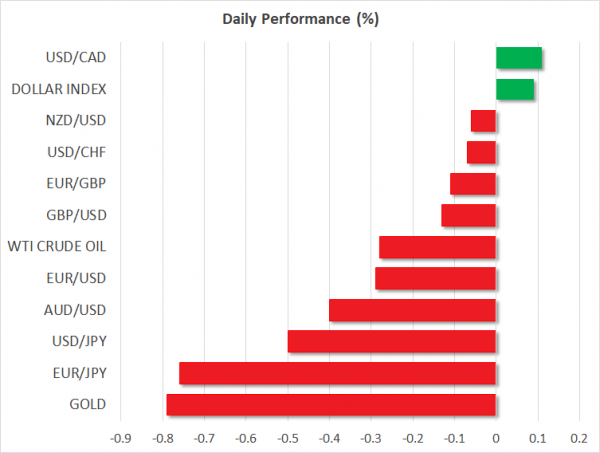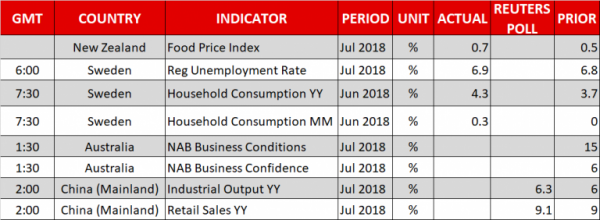Here are the latest developments in global markets:
FOREX: The US dollar index was little changed on Monday (+0.07%), while dollar/yen headed lower by 0.50%, completing a six-week low at 110.10 as political tensions between the US and Turkey enhanced interest for safer assets. Euro/dollar remained negative, last seen at 1.1385 (-0.23%) after it opened with a gap down today following Friday’s strong sell-off. The pair posted a 13-month trough as a slide in the Turkish lira sparked fears that Turkish borrowers could fail to submit loan payments to European banks, generating the risk of contagion. After hitting a record low of 7.21 against the dollar earlier today, Turkey’s lira found some support after the Turkish central bank announced a list of modest measures to protect the economy from the lira’s free-fall. Meanwhile, pound/dollar declined by 0.17% as a stronger dollar and concerns over a no-deal Brexit continue to weigh on the currency. The South African rand was also weak against the greenback (-2.59%) as the lira crisis unsettled other emerging market currencies. In antipodean currencies, aussie/dollar slipped by 0.41% to a more than 18-month low of 0.7247, while kiwi/dollar posted a new two-and-a-half-year low of 0.6549, losing -0.03% in the day. Dollar/loonie held near its opening level at 1.3144.
STOCKS: European equities were a sea of red on Monday, with the pan-European STOXX 600 falling by 0.51% at 1040 GMT, led by losses in financial and healthcare sectors. The blue-chip Euro STOXX 50 was down by 0.57%, near one-month lows. In Germany, the DAX retreated by 0.60.%, while the French CAC 40 fell by 0.35%. In Italy, the FTSE MIB 100 was down by 1.0%, while the British FTSE 100 was weaker by 0.56%. The Spanish IBEX 35 traded lower by 1.11%. Turning to the US, futures tracking the Dow Jones, S&P 500, and Nasdaq 100 were all in negative territory, pointing to a lower open today continuing the downward correction from last week.
COMMODITIES: Oil prices moved lower today with West Texas Intermediate (WTI) falling by 0.52% after OPEC predicted lower demand in the next year. In a monthly report, OPEC noted that the world will need 32.05 million bpd of crude from its 15 members in 2019, 130,000 bpd lower than it estimated in last month’s report. Brent crude declined by 0.22% below the $73 level. In precious metals, gold prices tumbled by 0.94%, reaching a fresh almost 17-month low of $1,198.86.
Day ahead: Politics and trade worries to drive markets; Chinese industrial production next in focus
The Turkish central bank announced its measures on the foreign exchange market on Monday, saying that banks will receive the liquidity needed to keep their operations moving, refraining from any rate hikes. Instead, it introduced higher collateral FX deposit limits for lenders’ lira transactions and altered reserve requirements ratios. But the Turkish lira received little support, with dollar/lira retreating slightly to 6.86 after touching a new all-time high of 7.21 earlier today. In other emergency currencies, the South African rand, the Indian rupee, the Russian ruble and the Mexican peso which felt the pain from the lira’s meltdown early today did not gain much either on the news, remaining in the red against the greenback. The euro held in negative territory as well, consolidating slightly below 1.1400. Investors are waiting to see how the US-Turkish dispute will evolve in the following sessions, as a report by the Financial Times last week stated that the ECB is concerned the lira’s tumble could expose European banks to defaults on loans taken by Turkish borrowers. A potential deterioration in Turkey’s economic and political conditions could affect the ECB’s monetary thinking, to the extent that it spills over into the euro area as well. Indeed, investors have pushed back the anticipated timing of the first 10bps ECB rate increase to December 2019, according to EONIA swaps.
The trade story is expected to continue to trouble investors this week as neither the US nor China show signs of backing down in their inflamed dispute, with the world’s two biggest economies exchanging another round of tariff warnings last week. Industrial production readings out of China early on Tuesday at 0200 GMT are expected to show that factory output has grown by 6.3% y/y in July, faster than in June when it marked an expansion of 6.0%. Separately, July’s retail sales are anticipated to increase by 9.1% compared to 9.0% in June. The data could signal that despite US tariffs on Chinese steel and aluminum imports taking effect early in June, industrial activity and consumption in China continued to grow at healthy levels. Having said that, any weakness cannot be excluded in the future as trade threats could weigh on business investment plans.
Meanwhile in Australia, the Commercial National Bank is scheduled to update its business surveys for the month of July on Tuesday at 0130 GMT and any significant upside surprise could help the aussie to gain some ground. Chinese data following the Australian business indicators (mentioned above) could also shake the aussie, as China is Australia’s biggest export partner.















